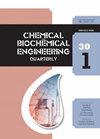γ-戊内酯的吸附:木质纤维素生物质转化为可发酵糖后溶剂回收的替代方法
IF 0.9
4区 生物学
Q4 BIOTECHNOLOGY & APPLIED MICROBIOLOGY
引用次数: 0
摘要
γ-戊内酯是溶解木质纤维素生物质部分的有效溶剂,尽管它抑制微生物活性。为了避免对微生物代谢的负面影响,即使是少量的γ-戊内酯也需要去除。本研究考察了γ-戊内酯在市售树脂上的吸附性能。考察了吸附效率、吸附平衡、pH效应和固定床柱条件。商业树脂Dowex Optipore L-493和pH 4.00对糖溶液中γ-戊内酯的最高去除率为39.92%,吸附量为413.78 mg g−1。双位点Langmuir吸附等温线是描述γ-戊内酯在商品树脂上吸附机理的最佳模型。因此,本研究表明,γ-戊酸酮可以通过吸附在商业树脂上从糖溶液中去除。此外,该工艺是回收溶剂和保持木质纤维素生物质部分中微生物活性的可行替代方案。本文章由计算机程序翻译,如有差异,请以英文原文为准。
Adsorption of γ-Valerolactone: An Alternative for Solvent Recovery after Conversion of Lignocellulosic Biomass to Fermentable Sugars
The γ-valerolactone is an effective solvent in solubilizing lignocellulosic biomass fractions, although it inhibits microbial activity. To avoid the negative effects on the me-tabolism of microorganisms, even small quantities of γ-valerolactone need to be removed. This study examined the adsorption of γ-valerolactone on the commercial resin. The removal efficiency, adsorption equilibrium, pH effects, and fixed-bed column conditions were investigated. The highest removal efficiency of γ-valerolactone from sugar solution was 39.92 %, with 413.78 mg g −1 γ-valerolactone adsorption capacity, observed with commercial resin Dowex Optipore L-493 and pH 4.00. Dual-site Langmuir adsorption isotherm was found to be the best-fitting model for describing the adsorption mech-anisms of γ-valerolactone on commercial resin. Thus, this study shows that γ-valerolac-tone could be removed from sugar solution by adsorption on commercial resin. In addition, the process is a viable alternative for the recovery of solvent and keeping the microbial activity in lignocellulosic biomass fractions.
求助全文
通过发布文献求助,成功后即可免费获取论文全文。
去求助
来源期刊
CiteScore
2.70
自引率
6.70%
发文量
23
审稿时长
>12 weeks
期刊介绍:
The journal provides an international forum for presentation of original papers, reviews and discussions on the latest developments in chemical and biochemical engineering. The scope of the journal is wide and no limitation except relevance to chemical and biochemical engineering is required.
The criteria for the acceptance of papers are originality, quality of work and clarity of style. All papers are subject to reviewing by at least two international experts (blind peer review).
The language of the journal is English. Final versions of the manuscripts are subject to metric (SI units and IUPAC recommendations) and English language reviewing.
Editor and Editorial board make the final decision about acceptance of a manuscript.
Page charges are excluded.

 求助内容:
求助内容: 应助结果提醒方式:
应助结果提醒方式:


